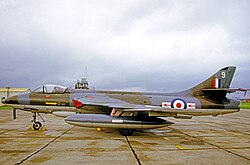| RMB Chivenor | |
|---|---|
| Near Braunton, Devon in England | |
 View looking south over RMB Chivenor | |
 Badge of the Royal Marines | |
| Site information | |
| Type | Royal Marines Base |
| Owner | Ministry of Defence |
| Operator | |
| Controlled by | |
| Condition | Operational |
| Website | RM Chivenor - Royal Navy |
| Location | |
| Coordinates | 51°05′14″N004°09′01″W / 51.08722°N 4.15028°W |
| Area | 222 hectares |
| Site history | |
| Built | 1940 |
| In use | 1940–1995 (Royal Air Force) 1995 – present (Royal Marines) |
| Garrison information | |
| Current commander | Lt Col R. Alderson RM |
| Occupants | Commando Logistic Regiment 24 Commando Regiment Royal Engineers Volunteer Cadet Corps |
Royal Marines Barracks Chivenor is a British military base used primarily by UK Commando Force. It is situated on the northern shore of the River Taw estuary, adjacent to the South West Coast Path, on the north coast of Devon, England. The nearest towns are Barnstaple and Braunton.
Contents
- Etymology
- History
- RAF Chivenor
- Transfer to Royal Marines
- Proposed closure
- Based units
- Royal Navy
- British Army
- Cadets
- Role and operations
- Commando Logistic Regiment
- 24 Commando Regiment Royal Engineers
- RMB Chivenor in the media
- References
- External links
Originally a civil airfield opened in the 1930s, the site was taken over by the Royal Air Force (RAF) and was operational between May 1940 and 1995 when it was transferred to the Royal Marines.




